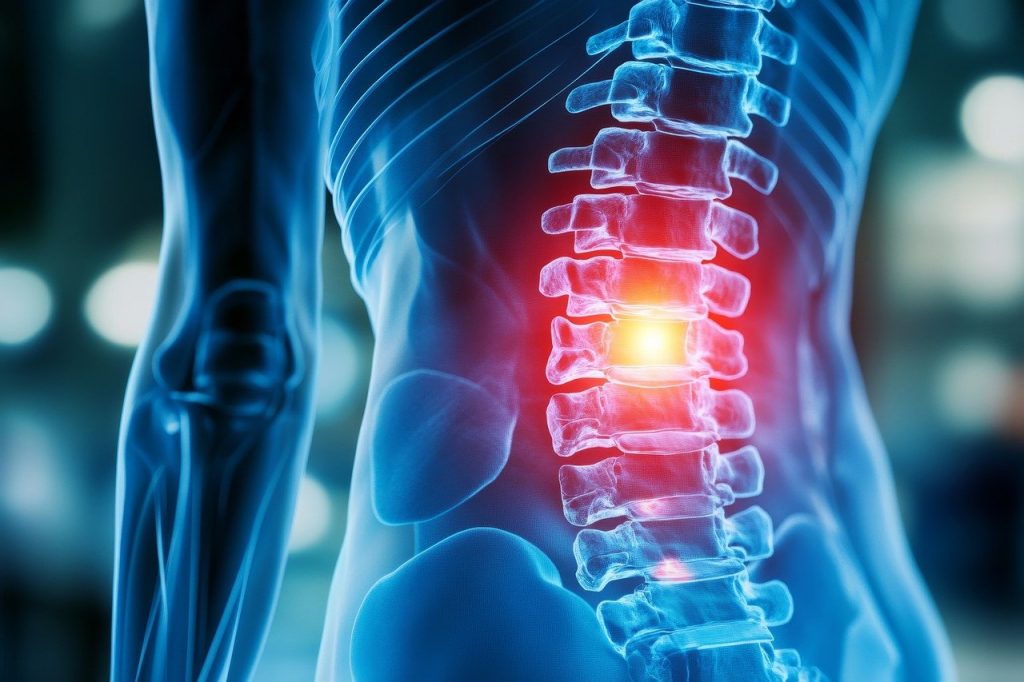Back Pain Refers To Discomfort or Pain Felt in the Back, Which Can Range From mild To Severe. It Can Occur in Any Region of The Spine, But it’s Most Commonly Felt in The Lower Back. Causes of Back Pain Include:
- Muscle or ligament strain: Due to lifting heavy objects or sudden awkward movements.
- Herniated or ruptured discs: The soft tissue inside the discs that cushion the vertebrae can bulge or rupture.
- Arthritis: Osteoarthritis can affect the lower back, leading to pain and stiffness.
- Skeletal irregularities: Conditions like scoliosis can cause back pain.
- Osteoporosis: Weak, brittle bones can cause fractures in the vertebrae, leading to pain.
Back pain can be acute (short-term) or chronic (lasting more than three months), and treatments range from rest and physical therapy to surgery in more severe cases
Back Pain Causes Problems in Our Body:
Back pain can have a significant impact on various parts of the body, leading to a range of issues. Some of the main problems include:
- Limited Mobility: Back pain often restricts movement, making it difficult to bend, lift, or engage in physical activities. This can reduce overall mobility and limit a person’s daily functioning.
- Muscle Weakness and Imbalance: Chronic back pain can cause muscles in the surrounding areas to become weak or overcompensate, leading to imbalances in the musculoskeletal system. This can worsen the pain or lead to injuries in other areas like the hips or legs.
- Poor Posture: Back pain may cause individuals to adopt poor posture to avoid discomfort, which can exacerbate the issue and lead to additional problems like neck pain, shoulder pain, or headaches.
- Nerve Compression: Conditions like herniated discs or spinal stenosis can compress nerves, leading to pain, numbness, or tingling sensations in other parts of the body, particularly the legs (sciatica).
- Fatigue and Weakness: Chronic pain can drain energy, leading to fatigue and muscle weakness. Pain may interfere with sleep, further reducing energy levels and leading to exhaustion.
- Emotional and Mental Strain: Persistent back pain can cause stress, anxiety, or depression, impacting overall mental health. The constant discomfort and reduced ability to engage in activities may lower the quality of life.
- Digestive Issues: In some cases, severe back pain, especially in the lower back, can affect the abdominal area and digestive system, potentially leading to constipation or other issues.
These problems illustrate how back pain can affect not only the spine but also various systems and functions in the body, underscoring the importance of addressing it effectively.

Ways To Cure Back Pain:
Curing back pain depends on the underlying cause and severity, but there are several approaches to alleviate and manage it. Here are some common methods:
1. Exercise and Stretching
- Strengthening Exercises: Focus on core-strengthening exercises, like planks or bridges, to support the spine.
- Stretching: Gentle stretches (e.g., hamstring stretches, child’s pose) can relieve muscle tension.
- Yoga: Yoga can improve flexibility and posture, often relieving back pain.
2. Posture Improvement
- Ergonomics: Maintain good posture at work or while sitting. Ensure your chair provides lumbar support, and avoid slouching.
- Standing and Walking: Try not to hunch over while standing or walking. Consider wearing shoes with good arch support.
3. Heat and Cold Therapy
- Heat: Use a heating pad or warm bath to soothe stiff muscles and improve blood flow.
- Cold: Ice packs can help reduce inflammation and numb sharp pain.
4. Over-the-Counter (OTC) Medications
- Pain Relievers: Nonsteroidal anti-inflammatory drugs (NSAIDs) like ibuprofen or acetaminophen can help relieve pain and inflammation.
- Topical Creams: Creams or gels with menthol or capsaicin can provide localized pain relief.
5. Massage Therapy
- A professional massage therapist can work out tight muscles and reduce pain. Regular massages can be effective for chronic back pain.
6. Physical Therapy
- A physical therapist can guide you through exercises that strengthen the back and improve mobility. This can also include posture and body mechanics training.
7. Chiropractic Care
- Chiropractors may perform spinal adjustments to relieve pain, especially for issues like misalignment or herniated discs.
8. Acupuncture
- Acupuncture, an ancient Chinese practice, involves inserting fine needles into specific points on the body to relieve pain. Some find this effective for back pain.
9. Weight Management
- Maintaining a healthy weight reduces stress on the spine and can alleviate pain over time.
10. Mind-Body Techniques
- Mindfulness and Meditation: These practices can help manage chronic pain by reducing stress and increasing relaxation.
- Cognitive Behavioral Therapy (CBT): CBT can be useful for managing chronic pain by changing thought patterns and behaviors associated with pain.
11. Proper Sleep Position
- Sleeping on your back with a pillow under your knees or on your side with a pillow between your legs can reduce pressure on your spine.
12. Avoid Prolonged Bed Rest
- While it might be tempting to rest a lot, too much bed rest can worsen back pain. Gradual movement and light activity help with recovery.
13. Medical Intervention
- Injections: Steroid injections or nerve blocks may be recommended for severe pain due to conditions like herniated discs.

Doctors Advise Us About Back Pain:
Doctors often provide a range of advice for managing back pain, depending on its severity and cause. Some common recommendations include:
- Stay Active: Gentle activities like walking or swimming can help maintain mobility and strengthen the muscles that support your back. Prolonged bed rest is usually discouraged as it can make the pain worse.
- Maintain Good Posture: Proper posture is important for preventing and alleviating back pain. This includes sitting up straight, avoiding slouching, and using ergonomic chairs or supportive cushions.
- Strengthening Exercises: Doctors may recommend physical therapy or specific exercises to strengthen the core muscles that support the spine, which can help prevent future episodes of back pain.
- Apply Heat or Cold: Alternating between heat and cold therapy can reduce inflammation and ease muscle tension. Cold packs are often recommended for acute pain, while heat can soothe chronic discomfort.
- Maintain a Healthy Weight: Carrying excess weight, especially around the midsection, can put extra strain on the spine. Maintaining a healthy weight through diet and exercise can reduce back pain.
- Medication: Over-the-counter pain relievers like ibuprofen or acetaminophen can be used to manage back pain. In some cases, doctors might prescribe muscle relaxants, anti-inflammatory drugs, or even injections for more severe pain.
- Mind Your Lifting Technique: Doctors often stress the importance of lifting heavy objects properly—by bending at the knees and keeping the back straight—to avoid injury.
- Avoid Smoking: Smoking can reduce blood flow to the spine, impair healing, and increase the risk of developing back pain.
- Consider Professional Therapies: If the pain persists, doctors might refer you to physical therapy, chiropractic care, or acupuncture. In severe cases, surgery may be considered, but it’s typically a last resort.
- Stress Management: Psychological stress can contribute to muscle tension and pain, so doctors might advise techniques like mindfulness, yoga, or counseling.
These Strategies Are Often Part of a Comprehensive Plan That Addresses Both The Symptoms And Root Causes of Back Pain.





